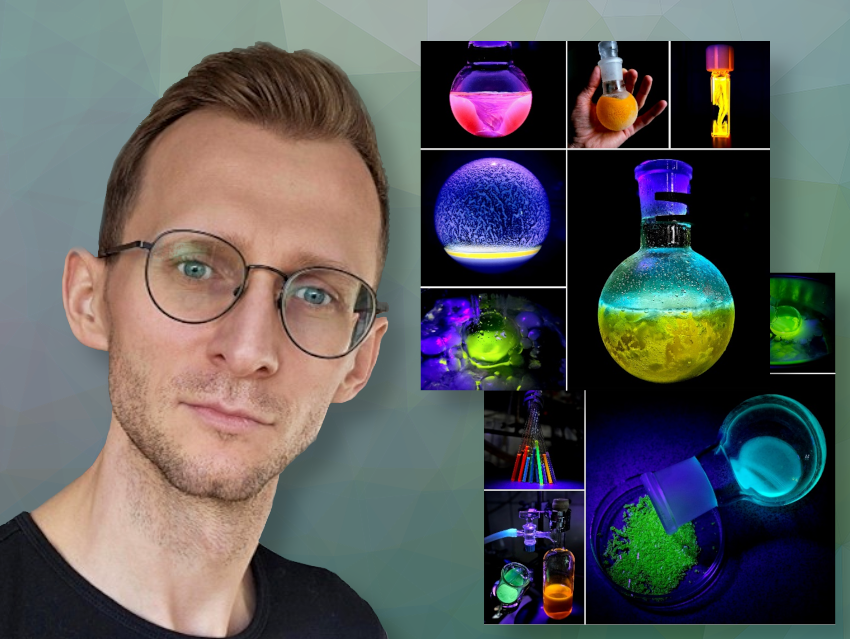Dr. Maciej Majdecki is a Postdoc in the group of Przemysław Gaweł at the Institute of Organic Chemistry at the Polish Academy of Sciences in Warsaw. He oversees several social media accounts, driven by a passion for promoting organic chemistry in an artistic and sophisticated manner and showcasing the wonders of chemistry through the captivating photos and videos produced daily in the lab. His online presence reaches over 35,000 followers across multiple profiles.
Here, he speaks to Dr. Vera Koester for ChemistryViews about his passion and experiences on social media. More about his research can be found in the recent Behind the Science Interview Singlet Fission in a New Series of Tetracene Oligomers with through-Space Coupling.
Could you tell us a little about your fascination with fluorescence and UV radiation in your research?
During my doctoral studies, I delved into the realm of sugar derivatives, which are characterized by their colorless and often oily nature. Employing them as catalysts in enantioselective reactions fueled my exploration. Despite my fascination with chiral compounds, the chemistry of that era lacked the vibrancy of colors. Over the last three years, I’ve been an integral part of a team dedicated to advancing optoelectronic materials. The compounds I synthesize are derivatives of polycyclic aromatic hydrocarbons, showcasing captivating fluorescence. Since my initial encounter with a UV flashlight, I foresaw its daily companionship, providing me with the ability to perceive more than ever before. The interplay of light with matter has become an enduring fascination since that pivotal moment.
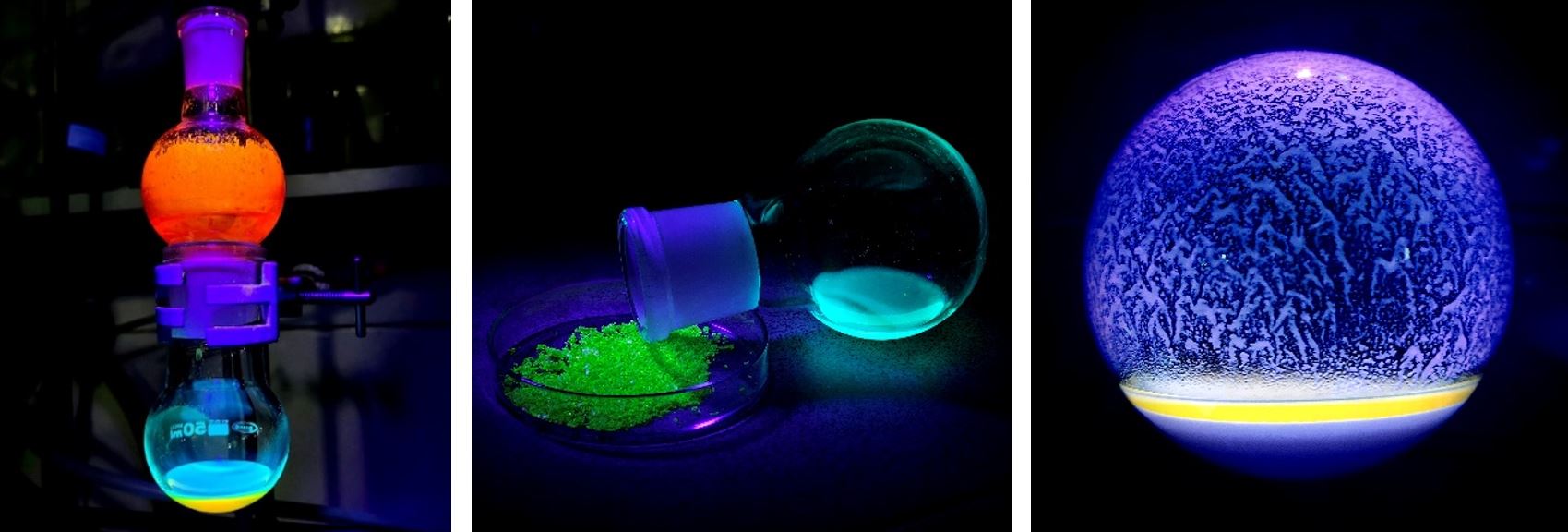
Do you always have the camera next to your experiments, or do you set aside specific times for photos and videos? Where do you get inspiration on how to present things?
The main characters of my photos and videos are exclusively the chemical compounds I use daily in the synthesis of target products for scientific publications. Capturing the true beauty of colors in UV light is not trivial. Often, my phone, used for taking pictures, struggles with an excess of emitted light, requiring precise adjustment of the angle and UV light to avoid unwanted reflections.
My passion for photography originated earlier, focusing primarily on hobbyist nature photography. Now, inspirations for creating new images arise spontaneously during the successive steps of my synthetic processes and my chemical knowledge.
My phone is always ready to react, especially when I anticipate or observe interesting changes in my chemical reactions. While making the right photo is crucial, the creativity of the message is equally important for me, and it emerges every day. This combination of science and art allows me not only to document processes but also to express myself artistically in daily chemical explorations.
What do your colleagues in the lab say?
My colleagues in the laboratory react very positively to my passion. They even borrow my UV flashlight out of curiosity to see if their compounds also glow with vibrant colors. Their interest always delights me and confirms that my fascination with chemistry resonates with others.
Friends and colleagues from the Institute also congratulate me with a smile on their faces for my small successes on social media. This undoubtedly gives me additional motivation to continue my activities. Positive reactions from the environment have a wonderful impact on my creativity and commit me to further development.
These pleasant responses serve as an inspiration for me and encourage me to explore new areas in my passion. I’m glad I can share this enthusiasm with others and build a positive atmosphere around my endeavors.

Running two very successful social media accounts is commendable. How do you balance your research responsibilities with your social media outreach efforts?
Previously, I was not a fan of social media and did not show much interest in it. Among my friends, there are many people younger than me, and I observed that social media is an integral part of their lives. Now, I have joined their ranks. Initially, I posted photos out of curiosity, but now it has become a pleasurable ritual for me after finishing work in the laboratory.
Usually, I take several photos each day, sometimes capturing various phenomena in a single day. I perform a few chemical reactions daily, which means there are truly many moments for capturing chemistry in photographs. I love synthesis, and immortalizing it is a pure pleasure during work.
This unique combination of a passion for chemical synthesis and the skill of using social media has created a new, satisfying dimension for me. Now, instead of avoiding social media, I use it as a tool to share my passion and build a community with similar interests.
What impact do you (hope to) achieve through your social media presence? What kind of reactions do you get? Do you know if you are inspiring non-chemists as well?
I strive for my followers to perceive in the field of chemistry what is truly hidden from our ordinary sight. The diversity of colors and their shades in UV light is so astonishing that it’s challenging to describe, yet it significantly differs from what we can observe in our daily lives. I aim to share with people a palette of colors that is concealed in the fascinating world of chemistry and remains inaccessible to them.
Additionally, my goal is to inspire future doctoral candidates to engage in research in this field. I want to captivate them with this extraordinary world and stimulate their interest in exploring this area. To advance science and encourage broader participation, it’s crucial to meet students where they spend a significant portion of their free time. Social media, widely utilized by students, emerge as a potent tool for acquiring knowledge and engaging with their culture and social concerns. It grants students autonomy in learning, extending beyond the traditional academic setting and breaking down barriers. Social media stand as a prime example of how we can employ innovative methods to disseminate educational content.
I receive numerous positive and uplifting comments on my profiles, which is crucial in such activities. I was surprised by how many people unrelated to chemistry follow my profiles with interest. They often inquire about the types of chemical compounds and how it’s possible for them to glow so intensely. This serves as a strong motivation for me to continue developing this endeavor and share the fascination with chemistry with an ever-expanding audience.
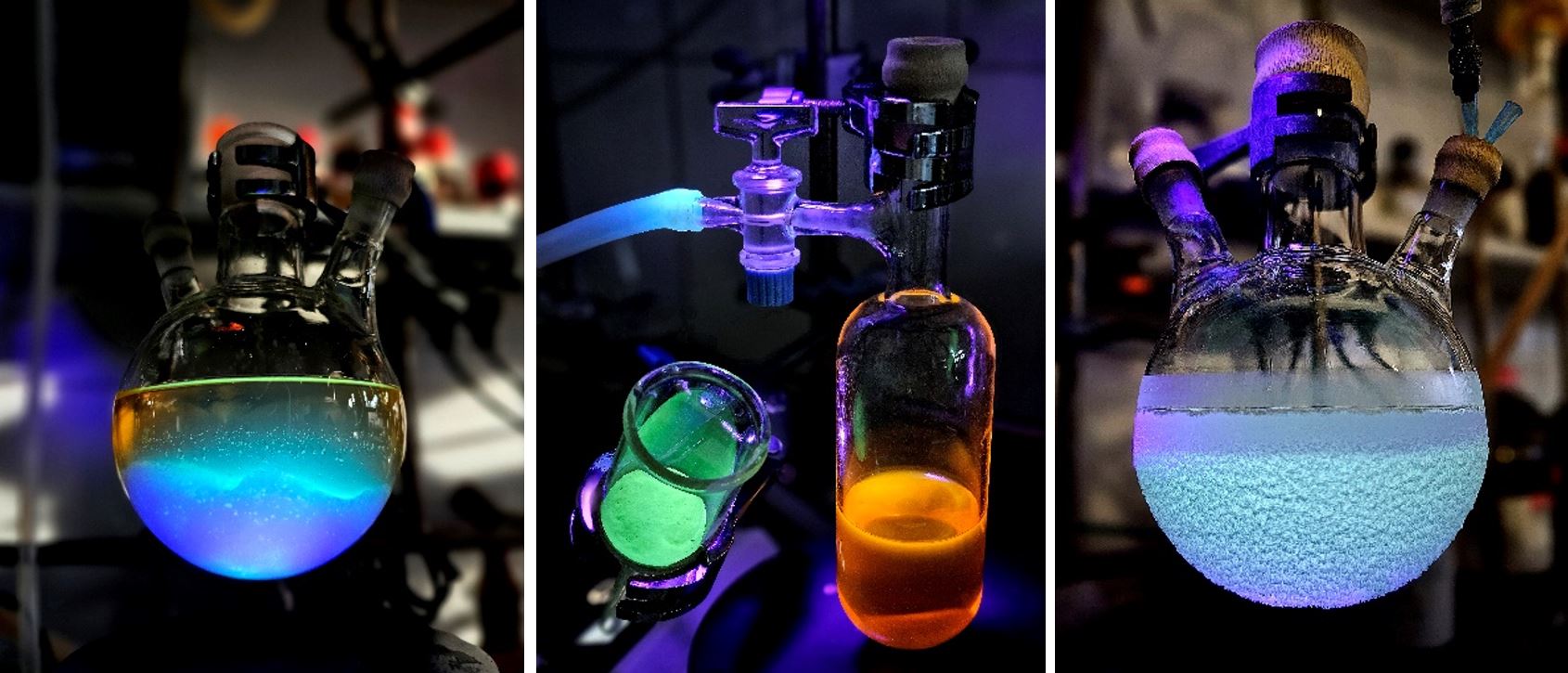
Are there any particular challenges or opportunities you’ve encountered in using social media as a platform to communicate scientific concepts and research results in this way?
Managing social media in this era of rapid technological development is a challenging task. Capturing the interest of potential followers must be genuinely original. I am not a typical blogger who showcases curiosities and well-known chemical compounds along with their transformations. My profiles resemble artistically colorful laboratory journals. Initially, I shared my photos primarily with the scientific community, but over time, I noticed responses from people with various backgrounds, including even from the younger generation, which brings me great joy.
Does presenting your research in attractive photos and videos have an impact on your research?
The presentation of my daily scientific work through photos and videos has gained recognition within the scientific community, as I observed during a recent conference. It was gratifying to notice that the majority of participants recognized me, undoubtedly enhancing the positive reception of the event. Nevertheless, my primary goal was to demonstrate to others that aesthetics, expressed through colors and forms, constitute a significant aspect of my work, despite the primary focus on publications in the most prestigious scientific journals.
Unexpected comments from a few random observers of my profile, who noted the beauty and fascination with the world of chemistry while appreciating the substantial research contribution, were profoundly uplifting. This affirmation that the combination of aesthetic aspects with profound scientific content is possible serves as an inspiration for me to continue sharing and presenting my work in this unique manner.
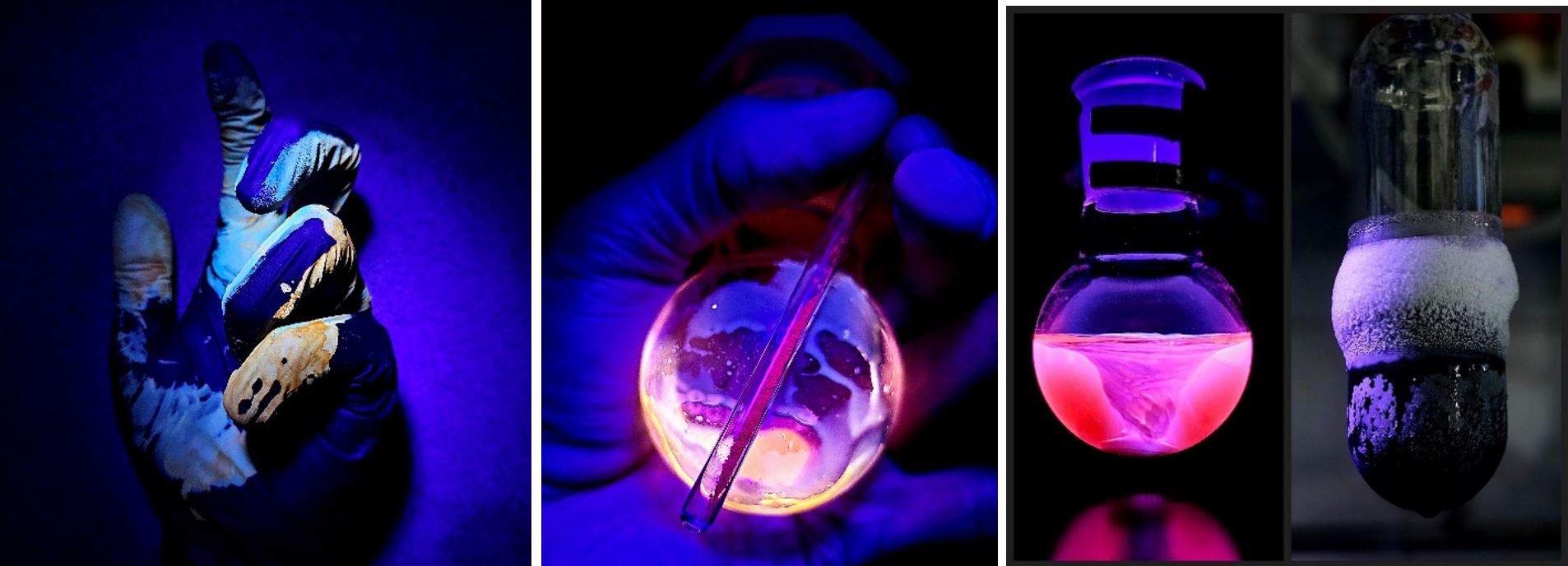
Anything else you would like to share with the readers of ChemistryViews?
Whenever someone addresses me with the title “Mr. PhD”, I always emphasize that my name is Maciek, and I am very pleased. In my scientific work, I prioritize openness, humor, and distance, considering these qualities to be fundamental. I believe that a positive attitude and lightness contribute to creativity and effectiveness in scientific research. Collaboration and sharing knowledge are integral aspects of my practice, and I am always ready to share my experiences with others. Additionally, I actively engage in the scientific community, promoting open exchange of ideas and collaboration. It is important for me not only to be a scientist but also to be a friendly and approachable colleague for everyone interested.
Thank you very much for the interview and for sharing these great photos and videos.

Maciej Majdecki studied chemistry at the University of Warsaw, Poland, and obtained his Ph.D. in 2016 from the same university. He currently is a postdoc in the group of Przemysław Gaweł at the Institute of Organic Chemistry (IOC) at the Polish Academy of Sciences (PAS), Warsaw.
Maciej Majdecki’s research focusses on developing new materials for organic electronics, with a primary focus on the singlet fission phenomenon. This ultrafast process holds immense potential for advancing the efficiency of next-generation photovoltaics and shows promising applications in quantum information science.
He oversees several social media accounts, driven by a passion for showcasing the wonders of chemistry through the captivating photos and videos he produces daily in the laboratory. His primary objective is to promote organic chemistry in an artistic and sophisticated manner.
You can find and enjoy his content on
- Instagram (@luminescent_chemist)
- X/Twitter (@MajdeckiMaciek)
- TikTok (@luminescent_chemist)
- YouTube (@luminescent_chemist)
And he is also the winner of the ChemistryViews Photo Competition “Perspectives of Chemistry”.
Selected Publications
- Maciej Majdecki, Chao-Hsien Hsu, Chih-Hsing Wang, Emily Hsue-Chi Shi, Magdalena Zakrocka, Yu-
Chen Wei, Bo-Han Chen, Chih-Hsuan Lu, Shang-Da Yang, Pi-Tai Chou, Przemysław Gaweł, Singlet Fission in a New Series of Systematically Designed through-Space Coupled Tetracene Oligomers, Angew. Chem. Int. Ed. 2024. https://doi.org/10.1002/anie.202401103 - Olga Swięch, Maciej Majdecki, Renata Bilewicz, PEGylated Network Nanostructured by Gold Nanoparticles for Electrochemical Sensing of Aromatic Redox and Nonredox Analytes,
ACS Applied Polymer Materials 2022, 1, 214-222. https://doi.org/10.1021/acsapm.2c01451 - Maciej Majdecki, Patryk Niedbała, Agata Tyszka-Gumkowska, Janusz Jurczak, Assisted by hydrogen-bond donors: Cinchona quaternary salts as privileged chiral catalysts for phase-transfer reactions, Synthesis 2021, 16, 2777-2786. https://doi.org/10.1055/a-1472-7999
- Maciej Majdecki, Piotr Grodek, Janusz Jurczak, Stereoselective α-Chlorination of β-Keto Esters in the Presence of Hybrid Amide-Based Cinchona Alkaloids as Catalysts, Journal of Organic Chemistry 2020, 1, 995-1001. https://doi.org/10.1021/acs.joc.0c02486
- Maciej Majdecki, Agata Tyszka-Gumkowska, Janusz Jurczak, Highly Enantioselective Epoxidation of α,β-Unsaturated Ketones Using Amide-Based Cinchona Alkaloids as Hybrid PhaseTransfer Catalysts, Organic Letters 2020, 21, 8687-8691. https://doi.org/10.1021/acs.orglett.0c03272
- Olga Swięch, Agata Krzak, Maciej Majdecki, Alicja Trębińska-Stryjewska, Maciej Wakuła, Piotr Garbacz, Renata Bilewicz, Water-soluble galactosamine derivative of β-cyclodextrin as protective ligand and targeted carrier for delivery of toxic anthracycline drug, International Journal of Pharmaceutics 2020, 589, 119834. https://doi.org/10.1016/j.ijpharm.2020.119834
- Maciej Majdecki, Patryk Niedbała, Janusz Jurczak, Amide-Based Cinchona Alkaloids as PhaseTransfer Catalysts: Synthesis and Potential Application, Organic Letters 2019, 21, 8085-8090. https://doi.org/10.1021/acs.orglett.9b03065
- Agata Krzak, Olga Swięch, Maciej Majdecki, Renata Bilewicz, Complexing daunorubicin with βcyclodextrin derivative increases drug intercalation into DNA, Electrochimica Acta 2017, 247, 139-148. https://doi.org/10.1016/j.electacta.2017.06.140
- Olga Swięch, Maciej Majdecki, Aleksander Dębiński, Agata Krzak, Tomasz. M Stępkowski, Grzegorz Wójciuk, Marcin Kruszewski, Renata Bilewicz, Competition between self-inclusion and drug binding explains the pH dependence of the cyclodextrin drug carrier – molecular modeling and electrochemistry studies, Nanoscale 2016, 8, 16733-16742. https://doi.org/10.1039/C6NR05833G
- Maciej Majdecki, Janusz Jurczak, Tomasz Bauer, Palladium‐Catalyzed Enantioselective Allylic
Substitution in the Presence of Monodentate Furanoside Phosphoramidites, ChemCatChem 2015, 7, 799-807. https://doi.org/10.1002/cctc.201402933
Also of Interest

Introducing the best photos of the photo competition “Perspectives of Chemistry”, and a big thank you to all participants

Certain substances emit light after the absorption of photons
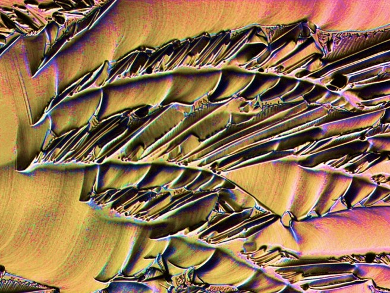
Amazing microscopic pictures of home-grown crystals
